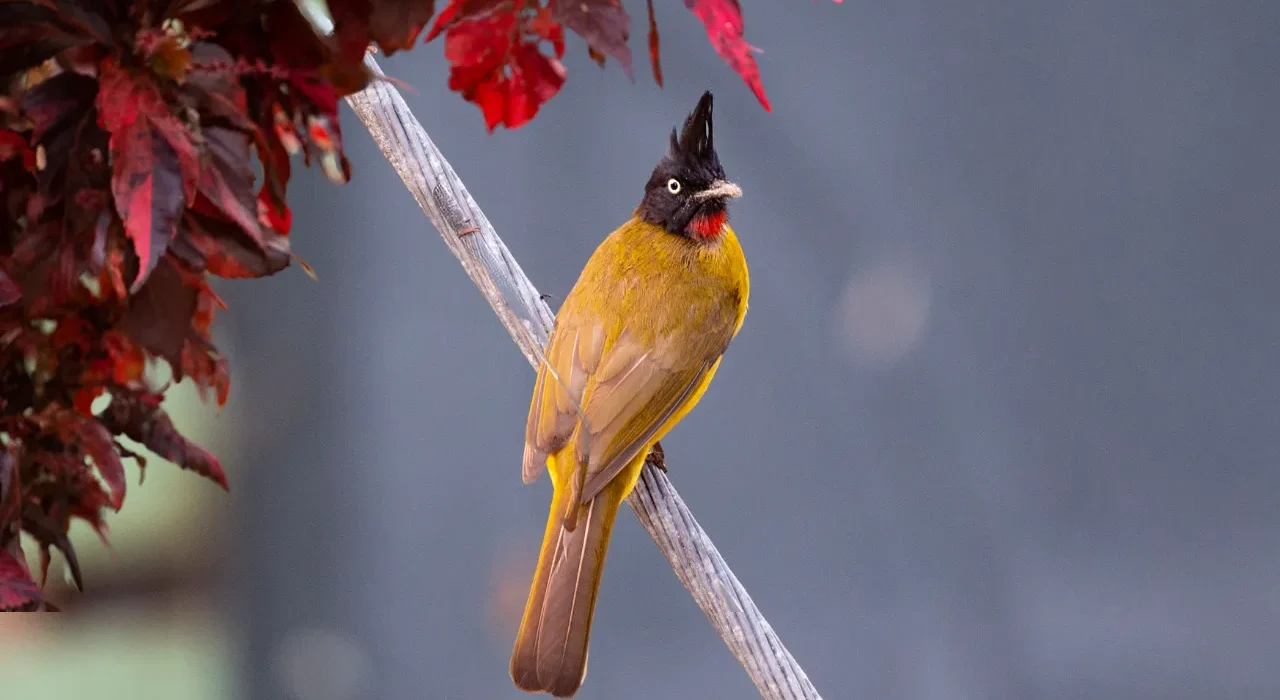The Fascinating World of Crested Woodland Birds: Nature’s Crowned Beauties
Have you ever wandered through a dense forest, the air filled with the songs of birds, and wondered what secrets lie in the treetops above? Among those secrets are the Crested Woodland Birds – charming species found in lush forests around the world. This article uncovers the mysteries of these birds, from their behaviour to their habitat, and why they’re such an important part of forest ecosystems.
What is a Crested Woodland Bird?
Crested Woodland Birds are a diverse group of birds recognized by their distinct crests – tufts of feathers on their heads that add both beauty and an element of mystery. These crests can serve a range of functions, from courtship displays to intimidation tactics. Some species within this group are known for their colourful crests, while others have more calm yet equally striking features.

Habitat
Crested woodland birds thrive in dense, tropical, and subtropical forests, ideal for nesting, hunting, and breeding

Diet
They are omnivores, feeding on insects, fruits, seeds, and sometimes small mammals.
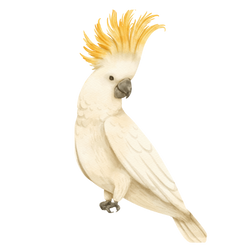
Behavior
Certain species, like cockatoos, are highly intelligent, using tools and solving complex problems.
Why are Crested Woodland Birds Important?
Crested woodland birds play a vital role in their ecosystems. As both predators and prey, they help maintain a balance within the food chain. They also contribute to seed dispersal, which aids in forest regeneration. Moreover, their presence is often an indicator of a forest’s health, as these birds are sensitive to environmental changes.
Rare Facts About Crested Woodland Birds
- Some species use their crests for communication, raising or lowering them to express emotions.
- The Crested Tit is one of the few birds that store food for the winter, hiding it in tree bark or crevices.
- Crested Cockatoos are known for their ability to mimic human speech and sounds, making them popular pets despite their high intelligence and need for stimulation.
1. Great Crested Flycatcher: The Charming Woodland Vocalist

The Great Crested Flycatcher is a captivating bird known for its striking appearance and bold personality. This medium-sized woodland bird is commonly found perched high in the canopy of deciduous forests, making it a delightful sight for birdwatchers and nature lovers. One of the most distinctive features of this bird is its vibrant yellow belly, complemented by an olive-brown back and a subtle crest that adds a touch of elegance to its appearance.
What truly sets the Great Crested Flycatcher apart is its loud, clear calls that echo through the woodlands. These vocalizations are a means of communication and are crucial in establishing territory during the breeding season. Interestingly, this species has a unique nesting behavior; it often decorates its nests with snakeskin pieces, which may help prevent predators.
The Great Crested Flycatcher is found in various habitats, including deciduous forests, woodland edges, and even urban parks. In the summer months, it is primarily located in the eastern United States and parts of Canada. As winter approaches, it migrates to Central and South America, where it thrives.
Great Crested Flycatcher facts
| Scientific Name | Myiarchus crinitus |
| Appearance | Vibrant yellow belly, olive-brown upper parts, reddish-brown tail, and a small crest. |
| Behavior | Known for loud calls, territoriality, and nesting in tree cavities, often incorporating snakeskin into their nests. |
| Habitat | Prefers deciduous forests, woodland edges, and urban parks. |
| Best Places to Watch | Eastern USA, Canada (during summer), Central and South America (in winter). |
| Size | Ranges from 17–21 cm (6.7–8.3 inches) in length. |
| Diet | Primarily insects, supplemented with fruits and berries in colder months. |
| Lifespan | Typically 9–10 years. |
| Conservation Status | Least Concern (IUCN). |
The Great Crested Flycatcher adds a lively charm to North American woodlands, making it a favourite among birdwatchers and nature lovers alike. With its striking colours and unique behaviours, this bird is a remarkable example of nature’s beauty. By understanding its habits and habitats, we can appreciate and protect these enchanting woodland inhabitants for future generations.
2. Black-Crested Bulbul: The Vibrant Forest Songster
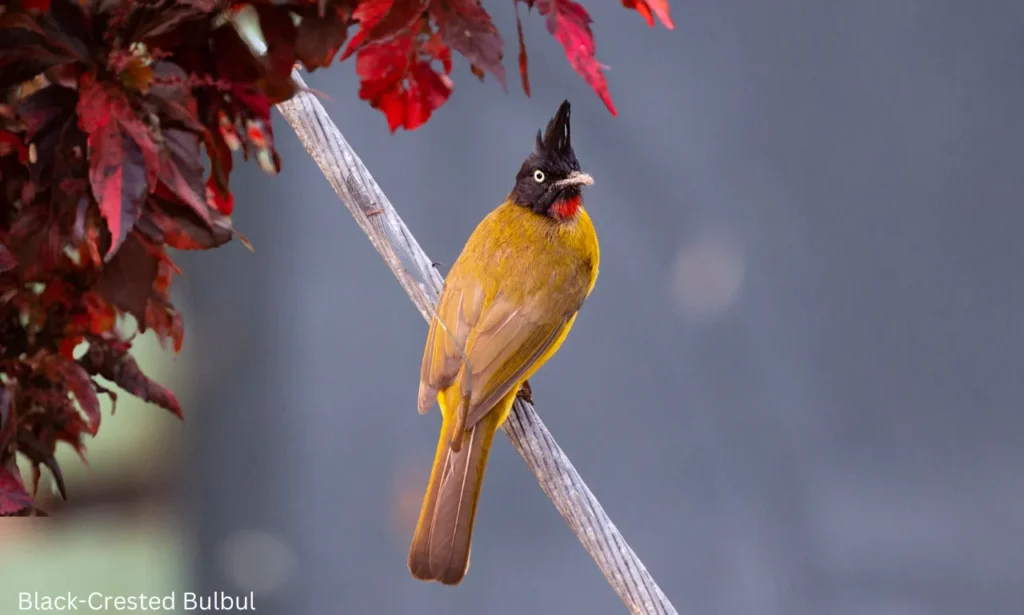
The Black-Crested Bulbul is a stunning bird, easily recognized by its distinctive black crest and bright yellow body. This medium-sized bulbul stands out among the dense vegetation of tropical and subtropical forests. With its sleek black head and crest contrasting with its vibrant yellow underparts, the Black-Crested Bulbul is a visual delight for Southeast Asian birdwatchers.
The bird is also well-known for its melodious, flute-like songs, which fill the forests with pleasant tunes. These calls are not only a means of communication but also serve to establish territory during the breeding season. The Black-Crested Bulbul is often seen in small groups, flitting through the forest canopy or foraging in fruit-bearing trees.
This species thrives in diverse habitats, from forests and woodlands to secondary-growth areas and gardens. It is a common resident across parts of South and Southeast Asia, making it a frequent sighting in its range.
Black-Crested Bulbul facts
| Appearance | Bright yellow underparts, black crest, and olive-brown upperparts. |
| Behaviour | Behavior |
| Habitat | Inhabits tropical forests, woodlands, secondary growth, and gardens. |
| Best Places to Watch | Southeast Asia, including Thailand, India, Malaysia, and Indonesia. |
| Size | Ranges from 19–20 cm (7.5–7.9 inches) in length. |
| Diet | Primarily fruits, supplemented with insects and small invertebrates. |
| Lifespan | Typically around 11 years. |
| Conservation Status | Least Concern (IUCN). |
3. Sulphur-Crested Cockatoo: The Intelligent, White-Feathered Icon
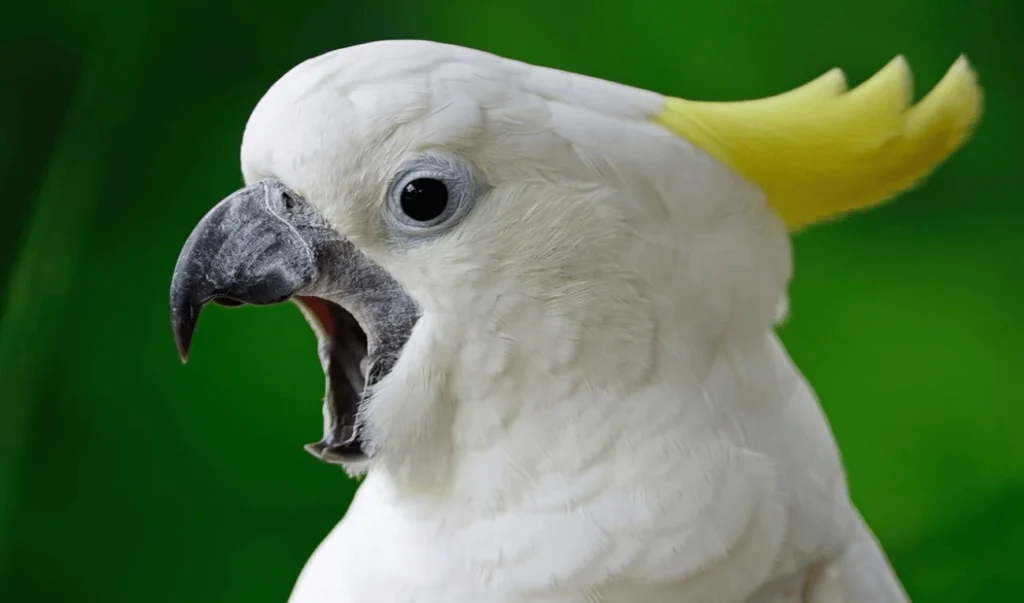
The Sulphur-Crested Cockatoo is one of the most recognizable and charismatic birds, famous for its brilliant white plumage and striking yellow crest. This large, intelligent parrot is native to Australia and New Guinea and is commonly found in wild and urban environments. The crest, which gives the bird its name, is used in displays of emotion, rising when the bird is excited or alarmed.
Known for their intelligence and social behavior, Sulphur-Crested Cockatoos often travel in flocks and can live for several decades. They are excellent problem-solvers and have even been observed using tools. Their loud, screeching calls are a common sound in their habitat, often used for communication within the flock.
These cockatoos are highly adaptable and thrive in various environments, from woodlands to urban parks. Their diet mainly consists of seeds, fruits, nuts, and sometimes insects. They have become a familiar and beloved sight in many parts of Australia.
Sulphur-Crested Cockatoo facts
| Appearance | White body, yellow crest, and black beak. |
| It is found in forests, woodlands, and urban areas across Australia and New Guinea. | Behavior |
| Habitat | Found in forests, woodlands, and urban areas across Australia and New Guinea. |
| Best Places to Watch | Australia, particularly in the eastern and northern regions and parts of New Guinea. |
| Size | Approximately 45–50 cm (17.7–19.7 inches) in length. |
| Diet | Primarily seeds, fruits, nuts, and sometimes insects. |
| Lifespan | Up to 70 years in the wild, often longer in captivity. |
| Conservation Status | Least Concern (IUCN). |
4. Crested Tit: The Tiny, Spirited Woodland Resident
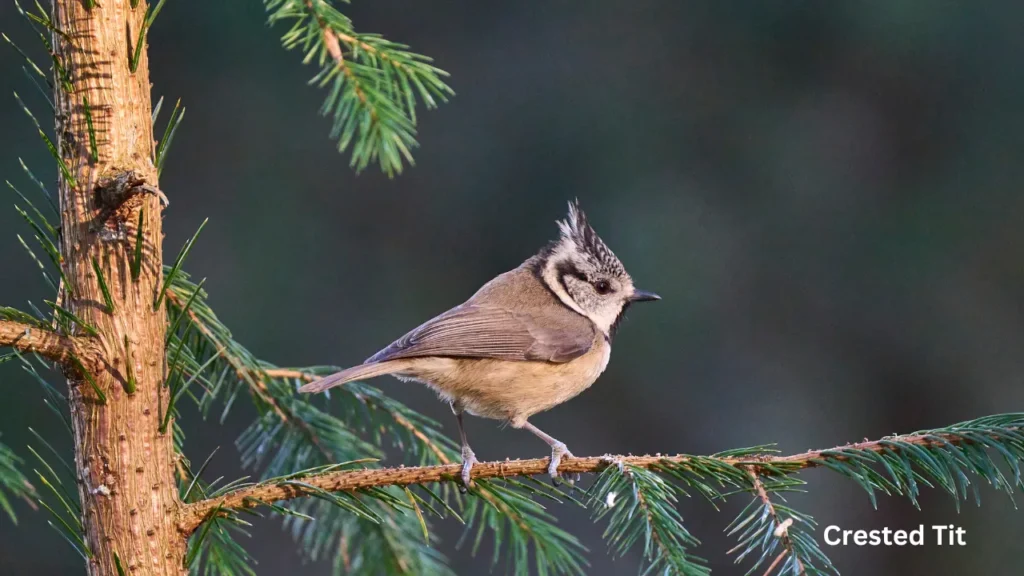
The Crested Tit is a small, energetic bird known for its distinctive black and white crest, which gives it a striking appearance. Native to the pine forests and woodlands of Europe, particularly in the northern and central regions, the Crested Tit is a delightful sight for bird enthusiasts. Its brown body, complemented by a black bib and white cheeks, makes the crest even more prominent.
This bird is highly active and agile, frequently seen flitting from branch to branch in search of food. Its diet mainly consists of insects, seeds, and small invertebrates. The Crested Tit is non-migratory, and it tends to stay within its home range year-round. Its call is a soft, high-pitched trill, often heard in the dense forests it inhabits.
The Crested Tit is most commonly found in coniferous woodlands, preferring areas with plenty of pine trees where it nests in tree cavities. It is a resident bird across much of Europe, particularly in Scotland, Scandinavia, and the Alps.
Crested Tit facts
| Appearance | Brown body with a black and white crest, black bib, and white cheeks. |
| Behaviour | Agile, energetic, and territorial; known for foraging in pine trees and nesting in tree cavities. |
| Habitat | Prefers coniferous forests and woodlands, particularly areas with pine trees. |
| Best Places to Watch | Northern and central Europe, including Scotland, Scandinavia, and the Alps. |
| Size | Approximately 11.5 cm (4.5 inches) in length. |
| Diet | Primarily insects and seeds, supplemented with small invertebrates. |
| Lifespan | Typically 4–6 years. |
| Conservation Status | Least Concern (IUCN). |
5. Crested Jay
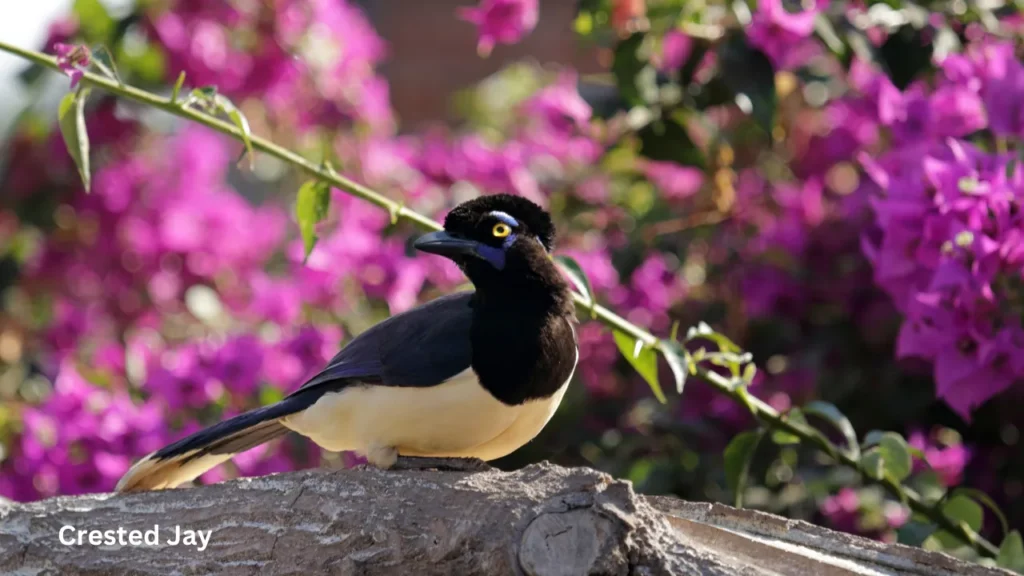
A distinctive bird species native to Southeast Asia, primarily found in lowland forests of countries like Malaysia, Indonesia, and Thailand. Known for its striking appearance, the Crested Jay features a prominent crest on its head, giving it a regal look. Its plumage is typically a mix of dark blues, blacks, and greys, which help it blend in with its forest habitat.
This species is relatively elusive and is often found in dense forest undergrowth, making it a challenge to spot in the wild. Its behavior is similar to that of other jays, as it forages for insects, small invertebrates, and occasionally fruits in the forest. The Crested Jay is known for its loud, harsh calls, which it uses to communicate within its flock or to warn of potential predators.
Despite its beauty, the Crested Jay remains somewhat understudied compared to other bird species, partly due to its preference for dense, remote forest regions. Conservation efforts in its native habitats are essential for protecting this species, as deforestation poses a significant threat to its population.
Crested Jay Facts
| Scientific Name | Platylophus galericulatus |
| Appearance | Black-and-white plumage, long tail, elegant black crest, sharp beak. |
| Behaviour | Secretive, quiet, stays high in the forest canopy, sharp calls. |
| Habitat | Tropical rainforests of Southeast Asia, particularly Borneo and Sumatra. |
| Best Places to Watch | Southeast Asian tropical forests, especially in national parks. |
| Size | 25–30 cm (9.8–11.8 inches) |
| Diet | Insects, small vertebrates, fruits, and berries. |
| Life Span | Estimated 7–10 years (exact data limited due to elusive nature). |
| Conservation Status | Near Threatened (IUCN), facing habitat loss due to deforestation. |
6. Black-Crested Titmouse

The Black-Crested Titmouse is a charming little bird with a lot of personality, found in the dry woodlands of central Texas and northeastern Mexico. Distinguished by its striking black crest, this species is closely related to the Tufted Titmouse but boasts a bolder look. These birds are energetic foragers, often seen hopping around branches or darting through foliage in search of insects, seeds, and berries.
Their curious nature, combined with their soft, whistled calls, makes them a favourite among birdwatchers. Despite their small size, they show incredible adaptability to various environments, from natural forests to urban areas.
Black-Crested Titmouse Facts
| Scientific Name | Baeolophus atricristatus |
| Appearance | Small bird with a prominent black crest, grey body, pale face, and black forehead. |
| Behavior | Active forager, usually in pairs or small groups; curious and social. |
| Habitat | Dry woodlands, oak forests, and urban parks in central Texas and northeastern Mexico. |
| Best Places to Watch | Central Texas (especially Hill Country) and northeastern Mexico. |
| Size | 14 cm (5.5 inches) |
| Diet | Insects, seeds, nuts, and berries. |
| Life Span | 2–5 years in the wild, potentially longer in captivity. |
| Conservation Status | Least Concern (IUCN) |
7. Crested Pigeon: The Unique, Graceful Australian Bird

The Crested Pigeon is a medium-sized bird easily recognized by its long, slender crest of black feathers. Native to the open woodlands, parks, and urban areas of Australia, the Crested Pigeon is a familiar sight across the country. Its soft grey body, with hints of pink and green on its wings, creates a striking appearance. The bold red-orange eyes add to its distinctive look.
This bird spends much of its time on the ground, foraging for seeds, grains, and small insects. The Crested Pigeon flies away quickly when disturbed, creating a high-pitched whistling sound with its wings. It’s often seen in pairs or small groups, calmly moving through open spaces.
The Crested Pigeon prefers open habitats with scattered trees and shrubs. It nests in simple twig structures in trees, and both parents help raise the chicks. Widely spread across Australia, this bird is a common and much-loved resident, particularly in cities and rural areas.
Crested Pigeon Facts
| Appearance | Soft grey plumage, iridescent wings, long pointed crest, red-orange eyes. |
| Behavior | Ground feeder, calm, makes whistling sound when flying, often seen in pairs or small groups. |
| Habitat | Open woodlands, parks, and urban areas across mainland Australia. |
| Best Places to Watch | Throughout Australia in parks, gardens, and woodlands. |
| Size | 30-35 cm (12-14 inches) |
| Diet | Seeds, grains, and small insects. |
| Life Span | Estimated 8-10 years. |
| Conservation Status | Least Concern, widespread and stable population. |
8. Blue Jay: The Vibrant, Vocal Forest Resident
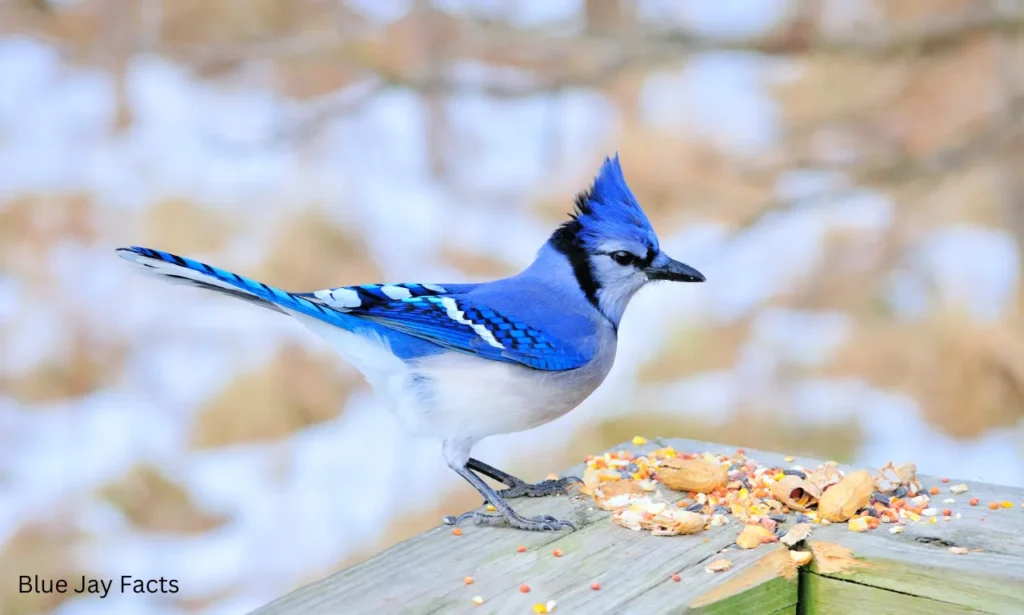
The Blue Jay (Cyanocitta cristata) is a striking and intelligent bird known for its bright blue plumage and loud, varied calls. It is native to North America, particularly common in forests, woodlands, and urban parks. Its vibrant blue feathers, white chest, black markings, and a crest on its head make it easily recognizable. The Blue Jay is known for its complex social behavior and its ability to mimic other bird calls, including hawks.
These birds are highly curious and are often seen foraging for food on the ground, including insects, nuts, and seeds. Blue Jays are also known to store food for later consumption, a behavior similar to squirrels. They are quite vocal, communicating with a wide range of calls, especially warning other birds of predators.
Blue Jay Facts
| Appearance | Bright blue feathers, white chest, black markings, and a prominent crest. |
| Behavior | Vocal, curious, stores food, forages on the ground, mimics calls. |
| Habitat | Forests, woodlands, and urban parks across North America. |
| Best Places to Watch | Eastern and central North America, especially in forests and suburban areas. |
| Size | 25-30 cm (9.8-11.8 inches) |
| Diet | Insects, nuts, seeds, fruits, and occasionally small vertebrates. |
| Life Span | Estimated 7-9 years in the wild. |
| Conservation Status | Least Concern, stable population. |
9. Great Crested Grebe: The Elegant Waterbird
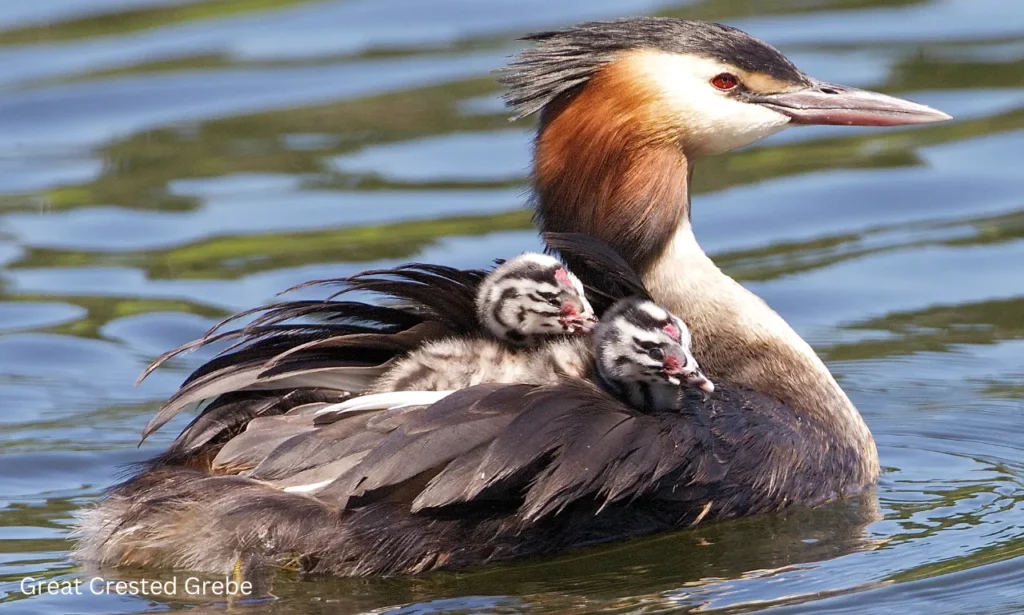
The Great Crested Grebe (Podiceps cristatus) is a large, graceful waterbird found in Europe, Asia, Africa, and Australia. It is easily recognized by its long neck, sharp beak, and elegant black and brown crest on its head, especially during the breeding season. The grebe is primarily known for its elaborate mating dance, in which pairs engage in synchronized swimming and head shaking.
Great Crested Grebes are superb divers and swimmers, spending most of their time in freshwater lakes and ponds. They feed on small fish, aquatic insects, and crustaceans. Their slender bodies and specialized feet allow them to move easily underwater, where they catch their prey. Unlike most birds, their feathers are waterproof, which helps them stay submerged for extended periods.
Great Crested Grebe Facts
| Appearance | Long neck, sharp beak, brown and black crest, sleek body. |
| Behavior | Expert diver and swimmer, known for elaborate courtship rituals. |
| Habitat | Freshwater lakes, ponds, and rivers across Europe, Asia, and Africa. |
| Best Places to Watch | Lakes and wetlands in Europe, Africa, Asia, and Australia. |
| Size | 46-51 cm (18-20 inches) |
| Diet | Small fish, aquatic insects, and crustaceans. |
| Life Span | Estimated 10-15 years in the wild. |
| Conservation Status | Least Concern, but some local populations are affected by habitat loss. |
10. Malabar Crested Lark

The Malabar Crested Lark is a ground-dwelling bird found in the dry scrublands and open woodlands of southern India. It’s best known for its modest brown plumage, which helps it blend into the earth, and its distinct crest, which gives it a regal look despite its small size.
This bird is often seen walking along the ground, foraging for seeds and insects. During mating season, its elaborate courtship displays, complete with raised crest and melodious singing, are a sight to behold.
Malabar Crested Lark facts
| Scientific Name | Galerida malabarica |
| Appearance | Brown, streaked plumage with a prominent crest, well camouflaged. |
| Behavior | Ground-dwelling, forages on the ground, elaborate courtship displays. |
| Habitat | Dry scrublands, open woodlands, and agricultural fields in southern India. |
| Best Places to Watch | Southern India, particularly in open grasslands and scrubby areas. |
| Size | 17–19 cm (6.7–7.5 inches) |
| Diet | Seeds, insects, and small invertebrates. |
| Life Span | 5–7 years |
| Conservation Status | Least Concern (IUCN), though affected by habitat degradation. |
Practical Tips for Birdwatchers
- Bring Binoculars: Woodland birds are often shy and prefer the forest canopy, making them harder to spot with the naked eye.
- Wear Earthy Colors: Blending in with the surroundings increases your chances of observing these birds without startling them.
- Go Early: Birds are most active in the early morning, so plan to be in the woods at dawn
Conclusion
This format provides a clear, engaging structure with both a rich description and practical facts about each bird. The tables allow for quick reference, making it more reader-friendly while enhancing SEO by including key details. Each bird is presented with sufficient depth to attract birdwatchers, wildlife enthusiasts, and SEO bots alike!FAQs about Crested Woodland Birds
FAQS
Do crested woodland birds migrate?
Some species, like the Great Crested Flycatcher, are migratory, traveling long distances between their breeding and wintering grounds.
What is the most famous crested woodland bird?
The Sulphur-Crested Cockatoo is well-known due to its bright yellow crest and social behavior.
Why do crested birds have crests?
Crests can be used for communication, courtship displays, and to intimidate rivals or predators.
Where can I see crested woodland birds?
These birds can be found in mature forests across North America, Europe, and Australia. Check local nature reserves and national parks for the best birdwatching spots.
Are crested woodland birds endangered?
Some species face habitat loss and are considered vulnerable, but conservation efforts are in place to protect them.

